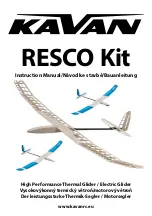
naishkites.com
naishkites.com
5.
Safety
Quick Release Features
To Release:
1
2
3
4
6b
7
6a
Sliding Stopper:
The Sliding Stopper should be set at a height at the top
of your depower range. Its function is to allow you to
rest the control bar against it and spin the bar. You can
push the Sliding Stopper up with the control bar during
a gust or if you want more depower.
5.
Safety
This chart is only to be used as a point of reference. It is based upon a rider who is 75kg (170 lbs) riding on a 132
cm twin tip board. Your kite size choice may vary based on your body weight, ability, board size, water conditions
and riding preferences. Please use common sense and your personal experience when selecting your kite size.
Check to see what size kite others are riding. Lighter riders should use smaller kites and heavier riders may need
a bigger size.
Charger
Knots
8
12
16
20
24
28
32
36
40
not recommended for 75kg rider
3.5
5
7
9
11
13
15
Bolt
Knots
8
12
16
20
24
28
32
36
40
not recommended for 75kg rider
3
5
6
7
8
9
10.5
12
14
16
Knots
8
12
16
20
24
28
32
36
40
Park
6
8
10
12
14
Torch
Knots
8
12
16
20
24
28
32
36
40
5
6
7
8
9
10
11
12
14
Wind Range Chart
Operating the Quick Release Trim Loop:
To activate the Quick Release Trim Loop: Grasp the
handle of the quick release trim loop and force it up the
QRTL line, away from your body.
Important:
It is your responsibility to maintain the
proper working order of the quick release mechanism.
Always inspect this piece prior to launching your kite.
Make sure the trigger mechanism is properly seated
before you ride, and occasionally while on the water.
There are two ways to do this:
1. Grasp the handle and pull it towards your body.
2. Briefly unhook from the loop, and then hook back in.
Release Pics 1-4:
To release, grasp the handle and force
it away from your body to open the loop.
Reload Pic 5:
Released QRTL.
Reload Pic 6A & B:
Slide the arm through the stainless
steel loop at the end of the QRTL.
Reload Pic 7:
Slide the handle down the line over the
arm.
Note:
You MUST test your Quick Releases before every
session in order to get used to the way they work. This is
the only way for you to be able to use them fast enough
in case of emergency. Remember that the Quick Release
devices have a limited lifetime and you must change
them after 250 hours of kiting. Our Quick Releases are
developed and designed to be used by a rider of 80kg
or less.
5
Sliding
Stopper
Fixed
Stopper
To Reload:
12
13
En
gl
is
h
Содержание 2011 kite
Страница 1: ...Kite User s Guide 2011...


























